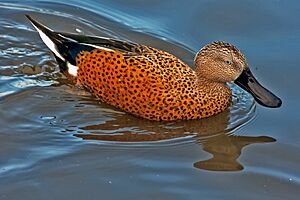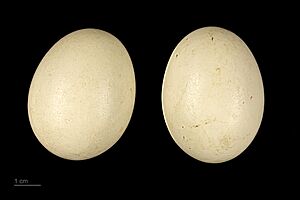Red shoveler facts for kids
Quick facts for kids Red shoveler |
|
|---|---|
 |
|
| Male at WWT Slimbridge, England | |
| Conservation status | |
| Scientific classification | |
| Genus: |
Spatula
|
| Species: |
platalea
|
 |
|
| Synonyms | |
|
Anas platalea Vieillot 1816 |
|
The red shoveler (Spatula platalea) is a special type of dabbling duck. These ducks live in the southern parts of South America. They are known for their unique, shovel-shaped bills!
Contents
What Does the Red Shoveler Look Like?
Red shovelers have a bill that looks like a spatula. This bill helps them scoop up food. They also have a bright green patch on their wings called a speculum. The feathers on their upper wings are light blue.
Male red shovelers are usually red, but their color can be lighter, even pinkish. Female shovelers often have bigger, darker bills. These ducks grow to be about 45 to 56 centimeters (18 to 22 inches) long. They weigh around 523 to 608 grams (1.1 to 1.3 pounds). Their wings can spread out about 66 to 73 centimeters (26 to 29 inches) wide.
Where Do Red Shovelers Live?
Red shovelers make their nests and raise their young in the southern half of South America. You can find them from Tierra del Fuego all the way north to Chile and most of Argentina. They also live on the Falkland Islands.
Small groups of these ducks also breed in southern Peru, Bolivia, and Paraguay. You might also see them in the very southern parts of Brazil and Uruguay. They live near coasts and sometimes further inland.
These ducks love shallow lakes and ponds with lots of tall reeds. They also live in coastal areas like mangrove swamps and marshes. You can find them in salty waters too, such as coastal lagoons and river mouths.
What Do Red Shovelers Eat and How Do They Live?
Red shovelers eat many different things. Their diet includes water plants like herbs, grasses, and algae. They also enjoy eating small water bugs and other tiny creatures.
Their special bill has a filter system inside. This helps them strain out small bits of food from the water. Red shoveler pairs often form during the winter. They have a loud courtship display before mating.
After mating, the female lays about 7 or 8 eggs. She sits on the eggs for about 25 to 26 days until they hatch. The young ducks can fly after about 40 to 45 days. Red shovelers sometimes move to different places. The ducks from the southernmost areas fly north during the colder winter months.
Protecting the Red Shoveler
The red shoveler is a common duck and can be found in many places. Because of this, it is not currently considered to be in danger. The IUCN Red List lists them as a "Least Concern" species. This means their population is stable and they are spread out over a very large area.
However, their homes, called wetlands, are facing some problems. For example, too many nutrients from farm runoff can get into the water. This is called eutrophication. It causes water plants to disappear, which makes it hard for the ducks to find food and build nests. Also, grazing animals like cattle can accidentally step on nests and destroy the plants the ducks need for cover.
Even though they are not considered endangered, it is important to protect these wetland areas. This helps make sure red shovelers have safe places to live, find food, and raise their young.




